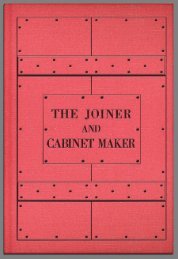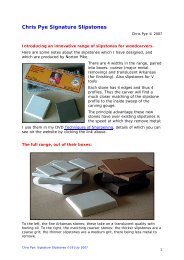Material Safety Data Sheet - Tools for Working Wood
Material Safety Data Sheet - Tools for Working Wood
Material Safety Data Sheet - Tools for Working Wood
You also want an ePaper? Increase the reach of your titles
YUMPU automatically turns print PDFs into web optimized ePapers that Google loves.
<strong>Material</strong> <strong>Safety</strong> <strong>Data</strong> <strong>Sheet</strong><br />
Section 1: Product and Company Identification<br />
RPM <strong>Wood</strong> Finishes Group, Inc. Company Phone number: (800) 522-8266<br />
P.O. Box 22000 CHEMTREC: (800) 424-9300<br />
Hickory, NC 28603<br />
Issue Date: 06/02/2007<br />
Product Name:<br />
Product Code:<br />
BRUSHING LACQUER GLOSS<br />
B612-00156, B612-00157<br />
Section 2: Hazards Identification<br />
EMERGENCY OVERVIEW<br />
Appearance: Clear Liquid<br />
Odor:<br />
Strong Solvent<br />
Principal Hazards:<br />
DANGER! Flammable.<br />
Harmful or fatal if swallowed. Causes eye irritation. Vapor harmful.<br />
Potential Health Effects: See Section 11 <strong>for</strong> more in<strong>for</strong>mation.<br />
Primary Routes of Exposure:<br />
Eye contact, ingestion, skin contact, inhalation, and absorption.<br />
Eye Contact:<br />
Product may cause eye irritation; signs and symptoms may include a burning sensation, redness, tearing, inflammation, blurred<br />
vision, and/or possible transient corneal injury.<br />
Ingestion:<br />
Skin Contact:<br />
Product if ingested may cause damage (including burns, scarring, and ulcerization) to mouth, throat, stomach, and digestive and<br />
central nervous systems. Signs and symptoms may include headache, drowsiness, dizziness, swelling, abdominal discom<strong>for</strong>t,<br />
burning sensation, shock or collapse, convulsions and/or bleeding. Post-ingestion vomitous in the lungs may cause chemical<br />
pneumonia.<br />
May be harmful if absorbed through the skin. Product may cause skin irritation; signs and symptoms may include drying,<br />
cracking, sensitization, reddening, discoloration, blistering and/or swelling.<br />
Inhalation:<br />
Product if inhaled may cause severe irritation or damage (including but not limited to burns, scarring, and ulcerization) to<br />
respiratory tract and central nervous system. Signs and symptoms may include weakness, headache, drowsiness, dizziness,<br />
swelling, abdominal discom<strong>for</strong>t, burning sensation, shock or collapse, convulsions, breathing difficulties, nasal per<strong>for</strong>ation,<br />
ulceration, heart damage, blindness, bleeding and/or death. NOTICE: Reports have associated repeated and prolonged<br />
occupational overexposure to solvents with permanent brain and nervous system damage. Intentional misuse by deliberately<br />
concentrating and inhaling the contents may be harmful or fatal.<br />
Issue Date: 06/02/2007<br />
Page 1 of 9<br />
File:<br />
IB612-00156_MSDS_ENGUSA_002.pdf
Product Name:<br />
<strong>Material</strong> <strong>Safety</strong> <strong>Data</strong> <strong>Sheet</strong><br />
BRUSHING LACQUER GLOSS<br />
Target Organs:<br />
Not Determined<br />
Carcinogenicity:<br />
This product contains carcinogens or potential carcinogens as listed by IARC or NTP.<br />
Hazardous Listing:<br />
Components of this product are considered hazardous per the OSHA Hazard Communication Standard (29 CFR<br />
1910.1200).<br />
Section 3: Composition/In<strong>for</strong>mation on Ingredients<br />
n-butyl acetate<br />
m-xylene<br />
cellulose nitrate, cellulose ester<br />
pm acetate<br />
alkyd resin non volatiles<br />
isobutanol<br />
o-xylene<br />
isopropanol<br />
ethylbenzene<br />
p-xylene<br />
diisononyl phthalate<br />
dipropylene glycol monomethyl ether<br />
toluene<br />
isobutyl acetate<br />
butanol<br />
benzene<br />
crystalline silica<br />
Chemical CAS Percent Composition<br />
123-86-4<br />
108-38-3<br />
9004-70-0<br />
108-65-6<br />
proprietary<br />
78-83-1<br />
95-47-6<br />
67-63-0<br />
100-41-4<br />
106-42-3<br />
28553-12-0<br />
34590-94-8<br />
108-88-3<br />
110-19-0<br />
71-36-3<br />
71-43-2<br />
14808-60-7<br />
20 - 30<br />
10 - 20<br />
1 - 10<br />
1 - 10<br />
1 - 10<br />
1 - 10<br />
1 - 10<br />
1 - 10<br />
1 - 10<br />
1 - 10<br />
1 - 10<br />
< 1<br />
< 1<br />
< 0.1<br />
< 0.1<br />
< 0.1<br />
< 0.1<br />
Section 4: First Aid Measures<br />
Eye Contact:<br />
If exposure occurs, flush the affected eye <strong>for</strong> at least 20 minutes. Tilt the head to prevent chemical from transferring to the<br />
uncontaminated eye. Seek medical attention immediately after flushing.<br />
Issue Date: 06/02/2007<br />
Page 2 of 9<br />
File:<br />
IB612-00156_MSDS_ENGUSA_002.pdf
Product Name:<br />
<strong>Material</strong> <strong>Safety</strong> <strong>Data</strong> <strong>Sheet</strong><br />
BRUSHING LACQUER GLOSS<br />
Ingestion:<br />
Do not induce vomiting. Dilute with water or milk. Never give fluids if the victim is unconscious or having convulsions. Seek<br />
medical attention immediately. Contact Poison Control Center immediately.<br />
Skin Contact:<br />
If exposure occurs, flush the affected area thoroughly with water <strong>for</strong> at least 15 minutes. Destroy contaminated clothing and shoes.<br />
Seek medical attention immediately.<br />
Inhalation:<br />
Remove to fresh air. If not breathing, administer CPR until help arrives or the victim starts to breathe on his own. If breathing is<br />
difficult, give oxygen. Seek medical attention immediately.<br />
Section 5: Fire Fighting Measures<br />
Extinguishing Media:<br />
Use alcohol foam, dry chemical, carbon dioxide or any Class B fire extinguishing agent. Water may be unsuitable <strong>for</strong> extinguishing<br />
fires. Water may be used to cool and prevent the rupture of containers that are exposed to the heat from a fire.<br />
Products of Combustion:<br />
Combustion may produce carbon monoxide, carbon dioxide, and irritating or toxic vapors and gases.<br />
Protection of Firefighters / Explosion Hazards:<br />
Evacuate all persons from the fire area to a safe location. Move non-burning material, as feasible, to a safe location as soon as<br />
possible. Fire fighters should be protected from potential explosion hazards while extinguishing the fire. Wear self-contained<br />
breathing apparatus (SCBA) and full fire-fighting protective clothing. Thoroughly decontaminate all protective equipment after use.<br />
Containers of this material may build up pressure if exposed to heat (fire). Use water spray to cool fire-exposed containers. Use<br />
water spray to disperse vapors if a spill or leak has not ignited. DO NOT extinguish a fire resulting from the flow of flammable<br />
liquid until the flow of the liquid is effectively shut off. This precaution will help prevent the accumulation of an explosive vapor-air<br />
mixture after the initial fire is extinguished.<br />
Section 6: Accidental Release Measures<br />
Follow personal protective equipment recommendations found in Section 8. Personal protection needs must be evaluated based on<br />
in<strong>for</strong>mation provided on this sheet and the special circumstances created by the spill including; the material spilled, the quantity of<br />
the spill, the area in which the spill occurred, and the training and the expertise of employees in the area responding to the spill.<br />
Never exceed any occupational exposure limits. Shut off ignition sources; including electrical equipment and flames. Do not allow<br />
smoking in the area. Do not allow the spilled product to enter public drainage systems or open waterways.<br />
Issue Date: 06/02/2007<br />
Page 3 of 9<br />
File:<br />
IB612-00156_MSDS_ENGUSA_002.pdf
Product Name:<br />
<strong>Material</strong> <strong>Safety</strong> <strong>Data</strong> <strong>Sheet</strong><br />
BRUSHING LACQUER GLOSS<br />
Section 7: Handling and Storage<br />
Handling:<br />
Empty containers may retain product residue or vapor. Do not pressurize, cut, weld, braze, solder, drill, grind, or expose container to<br />
heat, flame, sparks, static electricity, or other sources of ignition.<br />
Storage:<br />
Keep containers closed when not in use. Store in cool well ventilated space away from incompatible materials.<br />
Section 8: Exposure / Personal Protection<br />
OSHA 29 CFR 1910.1000 Air Contaminants – Tables:<br />
Chemical<br />
CAS<br />
Z-1 PEL<br />
(units as noted)<br />
Z-2 PEL<br />
(PPM)<br />
Z-3<br />
Status<br />
Specifically<br />
Regulated see:<br />
ACGIH TLV<br />
(units as noted)<br />
n-butyl acetate<br />
m-xylene<br />
cellulose nitrate, cellulose ester<br />
pm acetate<br />
alkyd resin non volatiles<br />
123-86-4<br />
108-38-3<br />
9004-70-0<br />
108-65-6<br />
proprietary<br />
710 MGM3 (150 PPM)<br />
435 MGM3 (100 PPM)<br />
150 PPM<br />
100 PPM<br />
isobutanol<br />
o-xylene<br />
isopropanol<br />
ethylbenzene<br />
p-xylene<br />
diisononyl phthalate<br />
78-83-1<br />
95-47-6<br />
67-63-0<br />
100-41-4<br />
106-42-3<br />
28553-12-0<br />
300 MGM3 (100 PPM)<br />
435 MGM3 (100 PPM)<br />
980 MGM3 (400 PPM)<br />
435 MGM3 (100 PPM)<br />
435 MGM3 (100 PPM)<br />
50 PPM<br />
100 PPM<br />
200 PPM<br />
100 PPM<br />
100 PPM<br />
dipropylene glycol monomethyl ether<br />
toluene<br />
isobutyl acetate<br />
butanol<br />
benzene<br />
crystalline silica<br />
34590-94-8<br />
108-88-3<br />
110-19-0<br />
71-36-3<br />
71-43-2<br />
14808-60-7<br />
600 MGM3 (100 PPM)<br />
700 MGM3 (150 PPM)<br />
300 MGM3 (100 PPM)<br />
200 PPM<br />
10 PPM<br />
*<br />
29 CFR 1910.1028<br />
100 PPM<br />
50 PPM<br />
150 PPM<br />
20 PPM<br />
0.5 PPM<br />
0.025 MGM3<br />
Issue Date: 06/02/2007<br />
Page 4 of 9<br />
File:<br />
IB612-00156_MSDS_ENGUSA_002.pdf
Product Name:<br />
<strong>Material</strong> <strong>Safety</strong> <strong>Data</strong> <strong>Sheet</strong><br />
BRUSHING LACQUER GLOSS<br />
Engineering Controls:<br />
Use adequate ventilation to maintain airborne concentrations at levels below permissible or recommended occupational exposure<br />
limits.<br />
Eye / Face Protection:<br />
Wear chemical-resistant glasses and/or goggles and a face shield when eye and face contact is possible due to splashing or spraying<br />
of material.<br />
Skin Protection:<br />
Wear chemical resistant footwear and clothing such as gloves, an apron or a whole body suit as appropriate.<br />
Respiratory Protection:<br />
A NIOSH-approved air-purifying respirator with the appropriate cartridge may be appropriate under certain circumstances where<br />
airborne concentrations are expected to exceed permissible exposure limits. Protection provided by air-purifying respirators is<br />
limited. Use a positive-pressure, air supplied respirator if there is potential <strong>for</strong> an uncontrolled release, exposure levels are not<br />
known or any other circumstances where air-purifying respirators may not provide adequate protection.<br />
General Hygiene Considerations:<br />
It is good practice to avoid contact with the product and/or its vapor, mists or dust by using appropriate protective measures.<br />
Wash thoroughly after handling and be<strong>for</strong>e eating or drinking.<br />
Section 9: Physical and Chemical Properties<br />
Physical State:<br />
Odor:<br />
Odor Threshold:<br />
pH:<br />
Freezing Point:<br />
Boiling Point:<br />
Flash Point ( o F):<br />
Evaporation Rate:<br />
Flammability (solid, gas):<br />
Upper Flammability Limit:<br />
Lower Flammability Limit:<br />
Vapor Pressure:<br />
Vapor Density:<br />
Clear Liquid<br />
Strong Solvent<br />
Not determined.<br />
Not determined.<br />
Not determined.<br />
Not determined.<br />
81 (CALC_)<br />
Not determined.<br />
Not determined.<br />
Not determined.<br />
Not determined.<br />
Not determined.<br />
Not determined.<br />
Issue Date: 06/02/2007<br />
Page 5 of 9<br />
File:<br />
IB612-00156_MSDS_ENGUSA_002.pdf
Product Name:<br />
<strong>Material</strong> <strong>Safety</strong> <strong>Data</strong> <strong>Sheet</strong><br />
BRUSHING LACQUER GLOSS<br />
Specific Gravity:<br />
Weight per Gallon (lbs):<br />
Solubility (water):<br />
Partition Coefficient (n-octanol/water):<br />
Auto-ignition Temperature:<br />
MIR Value:<br />
Coating VOC g/l:<br />
Coating VOC lbs/gal:<br />
<strong>Material</strong> VOC g/l:<br />
<strong>Material</strong> VOC lbs/gal:<br />
Solids VOL%:<br />
Solids WT %:<br />
0.95<br />
7.92<br />
Not determined.<br />
Not determined.<br />
Not determined.<br />
2.533<br />
705.52<br />
5.87<br />
705.38<br />
5.87<br />
19.17<br />
25.65<br />
Contains Photochemically Reactive Solvent.<br />
VOC data per US EPA guidelines. Some states and localities have guidelines more stringent than federal regulations.<br />
Section 10: Stability and Reactivity<br />
Stability:<br />
Stable under normal conditions.<br />
Conditions to Avoid/Incompatible <strong>Material</strong>s:<br />
Keep away from heat, sparks and flames.<br />
Hazardous Decomposition Products:<br />
Not determined.<br />
Issue Date: 06/02/2007<br />
Page 6 of 9<br />
File:<br />
IB612-00156_MSDS_ENGUSA_002.pdf
Product Name:<br />
<strong>Material</strong> <strong>Safety</strong> <strong>Data</strong> <strong>Sheet</strong><br />
BRUSHING LACQUER GLOSS<br />
Section 11: Toxicology In<strong>for</strong>mation<br />
Chemical CAS IARC NTP<br />
n-butyl acetate 123-86-4<br />
m-xylene<br />
cellulose nitrate, cellulose ester<br />
pm acetate<br />
alkyd resin non volatiles<br />
108-38-3<br />
9004-70-0<br />
108-65-6<br />
proprietary<br />
isobutanol 78-83-1<br />
o-xylene 95-47-6<br />
isopropanol 67-63-0<br />
ethylbenzene<br />
100-41-4<br />
p-xylene<br />
106-42-3<br />
diisononyl phthalate<br />
28553-12-0<br />
dipropylene glycol monomethyl ether 34590-94-8<br />
toluene<br />
108-88-3<br />
isobutyl acetate<br />
110-19-0<br />
butanol<br />
71-36-3<br />
benzene<br />
71-43-2<br />
crystalline silica<br />
14808-60-7<br />
*<br />
*<br />
Toxicological evaluation of this product as a whole has not been per<strong>for</strong>med. Individual components that are potential or known<br />
carcinogens are listed above.<br />
Section 12: Ecological In<strong>for</strong>mation<br />
Ecological evaluation of this material has not been per<strong>for</strong>med; however, do not allow the product to be released to the<br />
environment without governmental approval/permits.<br />
Issue Date: 06/02/2007<br />
Page 7 of 9<br />
File:<br />
IB612-00156_MSDS_ENGUSA_002.pdf
Product Name:<br />
<strong>Material</strong> <strong>Safety</strong> <strong>Data</strong> <strong>Sheet</strong><br />
BRUSHING LACQUER GLOSS<br />
Section 13: Disposal Considerations<br />
Waste from this material may be a listed and/or characteristic hazardous waste. Dispose of material, contaminated<br />
absorbent, container and unused contents in accordance with local, state, and federal regulations.<br />
Section 14: Transportation In<strong>for</strong>mation<br />
DOT Basic description:<br />
UN1263, PAINT, 3, III<br />
See 49 CFR 172.101 <strong>for</strong> Special Provisions, Packaging, and Quantity Limitations.<br />
Section 15: Regulatory In<strong>for</strong>mation<br />
Chemical Name<br />
CAS<br />
CERCLA<br />
CERCLA RQ<br />
EPCRA EHS<br />
EPCRA TPQ<br />
SARA 313<br />
TSCA<br />
DSL<br />
EINECS<br />
Proposition 65<br />
WHMIS<br />
n-butyl acetate<br />
123-86-4<br />
*<br />
5000 LBS<br />
* * *<br />
*<br />
m-xylene<br />
108-38-3<br />
* 100 LBS<br />
*<br />
*<br />
*<br />
*<br />
*<br />
cellulose nitrate, cellulose ester<br />
9004-70-0<br />
*<br />
100 LBS<br />
*<br />
*<br />
pm acetate<br />
108-65-6<br />
*<br />
*<br />
*<br />
alkyd resin non volatiles<br />
proprietary<br />
isobutanol<br />
78-83-1<br />
*<br />
5000 LBS<br />
*<br />
*<br />
*<br />
*<br />
o-xylene<br />
95-47-6<br />
*<br />
100 LBS<br />
*<br />
*<br />
*<br />
*<br />
*<br />
isopropanol<br />
67-63-0<br />
*<br />
*<br />
*<br />
*<br />
*<br />
ethylbenzene 100-41-4<br />
*<br />
1000 LBS<br />
*<br />
*<br />
*<br />
*<br />
*<br />
*<br />
p-xylene<br />
106-42-3<br />
*<br />
100 LBS<br />
*<br />
*<br />
*<br />
*<br />
*<br />
diisononyl phthalate<br />
28553-12-0<br />
*<br />
*<br />
*<br />
*<br />
dipropylene glycol monomethyl ether<br />
34590-94-8<br />
*<br />
*<br />
*<br />
*<br />
toluene<br />
108-88-3<br />
*<br />
1000 LBS<br />
*<br />
*<br />
*<br />
*<br />
*<br />
*<br />
isobutyl acetate<br />
110-19-0<br />
*<br />
5000 LBS<br />
*<br />
*<br />
*<br />
*<br />
butanol<br />
71-36-3<br />
*<br />
5000 LBS<br />
*<br />
*<br />
*<br />
*<br />
*<br />
benzene<br />
71-43-2<br />
*<br />
10 LBS<br />
*<br />
*<br />
*<br />
*<br />
*<br />
*<br />
crystalline silica<br />
14808-60-7<br />
*<br />
*<br />
*<br />
*<br />
*<br />
WARNING: This product contains a chemical known to the state of Cali<strong>for</strong>nia to cause cancer and birth defects, or<br />
other reproductive harm.<br />
Issue Date: 06/02/2007<br />
Page 8 of 9<br />
File:<br />
IB612-00156_MSDS_ENGUSA_002.pdf
Product Name:<br />
<strong>Material</strong> <strong>Safety</strong> <strong>Data</strong> <strong>Sheet</strong><br />
BRUSHING LACQUER GLOSS<br />
Section 16: Other In<strong>for</strong>mation<br />
IMPORTANT: WHILE THE DESCRIPTIONS, DATA AND INFORMATION CONTAINED HEREIN ARE PRESENTED IN<br />
GOOD FAITH AND BELIEVED TO BE ACCURATE, IT IS PROVIDED FOR YOUR GUIDANCE ONLY. BECAUSE<br />
MANY FACTORS MAY AFFECT PROCESSING OR APPLICATION/USE, WE RECOMMEND THAT YOU PERFORM<br />
AN ASSESSMENT TO DETERMINE THE SUITABILITY OF A PRODUCT FOR YOUR PARTICULAR PURPOSE PRIOR<br />
TO USE. NO WARRANTIES OF ANY KIND, EITHER EXPRESSED OR IMPLIED, INCLUDING FITNESS FOR A<br />
PARTICULAR PURPOSE, ARE MADE REGARDING PRODUCTS DESCRIBED, DATA OR INFORMATION SET<br />
FORTH. IN NO CASE SHALL THE DESCRIPTIONS, INFORMATION,OR DATA PROVIDED BE CONSIDERED A PART<br />
OF OUR TERMS AND CONDITIONS OF SALE. FURTHER, THE DESCRIPTIONS, DATA AND INFORMATION<br />
FURNISHED HEREUNDER ARE GIVEN GRATIS. NO OBLIGATION OR LIABILITY FOR THE DESCRIPTION, DATA<br />
AND INFORMATION GIVEN ARE ASSUMED. ALL SUCH BEING GIVEN AND ACCEPTED AT YOUR RISK.<br />
HMIS Codes Health 2 Flammability 3 Reactivity 0<br />
Key to Abbreviations:<br />
* Item appears on indicated list (or inventory)<br />
ACGIH<br />
American Conference of Governmental Industrial Hygienists<br />
CAS<br />
Chemical Abstract Service Registry Number<br />
CERCLA<br />
Comprehensive Environmental Response, Compensation, and Liability Act<br />
CERCLA RQ CERCLA Reportable Quantity<br />
CFR<br />
Code of Federal Regulations<br />
CPR<br />
Cardiopulmonary resuscitation<br />
DSL<br />
Domestic Substances List of Canada<br />
EINECS<br />
European Inventory of Existing Chemical Substances<br />
EPCRA<br />
Emergency Planning and Community Right-to-know Act<br />
EPCRA EHS EPCRA Extremely Hazardous Substance<br />
EPCRA TPQ EPCRA Threshold Planning Quantity<br />
o F<br />
Fahrenheit degrees<br />
g/l<br />
Grams per liter<br />
gal<br />
Gallons<br />
IARC<br />
International Agency <strong>for</strong> Research on Cancer<br />
lbs or LBS Pounds<br />
MGM3<br />
Milligrams per cubic meter<br />
MIR<br />
Maximum Incremental Reactivity<br />
MSDS<br />
<strong>Material</strong> <strong>Safety</strong> <strong>Data</strong> <strong>Sheet</strong><br />
NIOSH<br />
National Institute of Occupational <strong>Safety</strong> and Health<br />
NTP<br />
National Toxicology Program<br />
OSHA<br />
Occupational <strong>Safety</strong> and Health Administration<br />
PEL<br />
Permissible Exposure Limit<br />
PPM<br />
Parts per million<br />
Proposition 65 Cali<strong>for</strong>nia's Safe Drinking Water and Toxic En<strong>for</strong>cement Act<br />
SARA<br />
Superfund Amendments and Reauthorization Act<br />
TLV<br />
Threshold Limit Value<br />
TSCA<br />
Toxic Substances Control Act<br />
USEPA<br />
United States Environmental Protection Agency<br />
VOC<br />
Volatile Organic Compound<br />
VOL<br />
Volume<br />
WT<br />
Weight<br />
WHMIS<br />
Canadian Workplace Hazardous <strong>Material</strong>s In<strong>for</strong>mation System<br />
UN<br />
United Nations<br />
Issue Date: 06/02/2007<br />
Page 9 of 9<br />
File:<br />
IB612-00156_MSDS_ENGUSA_002.pdf













